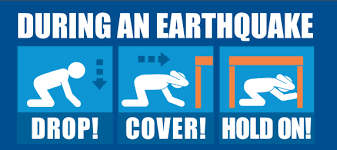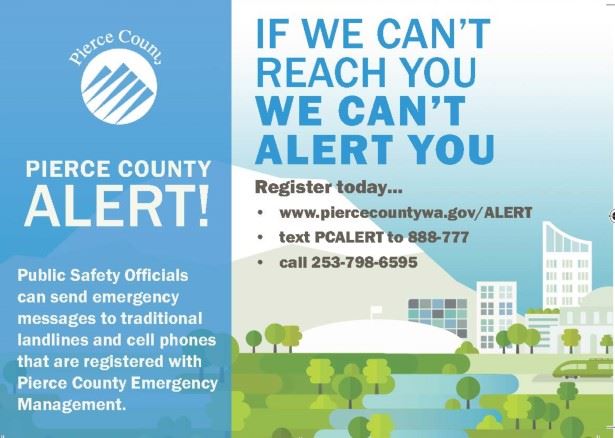Emergency Preparedness
Pierce County ALERT
Ready, Set, Go! Know What To Do In An Emergency
With smoke recently inundating our region and the evacuations for the wildfires in the Spokane area on people’s minds, we are participating in a regional “Ready, Set, Go!” Evacuation Campaign. This initiative aims to simplify evacuation messages to the public. These clear, straightforward messages are intended to save lives as people prepare to evacuate. The “Ready, Set, Go!” evacuation campaign provides clear instructions on responding to the three levels of evacuations (traditionally Levels 1, 2, and 3). This evacuation program will be used in our area for all hazards: fires, floods, earthquakes, volcanoes, and storms. In an emergency, we will use the graphics in this post to communicate how you should respond to the threat.
Level 1 – Be Ready
Be aware of the danger in your area and start preparing for possible evacuation.
Monitor local media and check on neighbors. If you do not already have an evacuation plan or a Go! kit, assemble these now. Conditions can change suddenly, and you may not receive a Level 2 “Be Set” warning before you are ordered to Level 3 “Go Now!” Prepare both the inside and outside of your home. Leave if you feel unsafe — do not wait for an official evacuation order.
Level 2 – Be Set
Short-notice evacuation is likely in your area.
Be prepared for sudden evacuation. People who need help or more time to evacuate — people with disabilities, people with small children, people with medical conditions, and people with large animals — should evacuate now. Ensure your evacuation plan checklist is complete and that your Go! kit is in your vehicle. Stay informed and be aware of alerts from local law enforcement and fire departments. Always remember to leave if you feel unsafe; do not wait for an official evacuation order.
Level 3 – Go Now
Evacuate immediately from your area.
Go now! Danger in your area is current or imminent. Follow directions from law enforcement or fire departments and do not return home until officials have determined it is safe. Notification that it is safe to return home will be given as soon as possible.
Earthquakes - What to Do?
Earthquakes can bring mild to violent shaking and can occur anytime, anywhere. This guide can help you protect yourself, your family, and your property before, during, and after an earthquake.

Low-Cost, No-Cost Preparedness
- Download or order your free preparedness products to help your family plan and prepare for the next emergency. www.ready.gov/publications
- Drills aren’t just for your toolbox. Practice emergency drills with your family regularly.
- Emergencies can happen anytime, and less than half of American families have a communication plan. Plan ahead: www.ready.gov/kids/make-a-plan
- Make preparing fun for kids! Go on a scavenger hunt around your house for items you already have to add to your disaster supply kit. Follow this list: www.ready.gov/kit and see how many items you can check off!
- Know what disasters and hazards could affect your area, how to get emergency alerts, and where you would go if you and your family need to evacuate. Visit: www.ready.gov/be-informed.
Teach Youth About Preparedness
- Review your family emergency communications plan with kids at your next household meeting.
- Need tips for talking to your kids about natural disasters? Visit www.ready.gov/kids/parents
- Many Americans aren’t familiar with their child’s school evacuation & reunification plans. Are you?
- Kids can become Disaster Masters with this @Readygov preparedness game: www.ready.gov/kids/games
- Get involved in Teen CERT. Find opportunities by learning about Teen CERT online: www.ready.gov/kids/teen-cert
- Your community needs YOU! Find opportunities to help your community here: www.ready.gov/youth-preparedness
Make a Plan
- Prepare To Protect means preparing to protect everyone you love. Start by making a plan before disasters and emergencies strike. www.ready.gov/plan
- Discuss with your household or family how you will communicate if there is an emergency.
- Decide and practice your emergency plan with members of your household.
- Houses, mobile homes, apartments, and high-rise buildings have different evacuation considerations. Make a plan for each: www.ready.gov/plan-for-locations
- Involve your entire family, including your children, in planning for disasters and emergencies so they are prepared, not afraid www.ready.gov/plan
Build a Kit
- Create or update your emergency supplies with this list: www.ready.gov/kit
- Make sure your emergency kit is ready to go in case you need evacuate. Include:
- Enough food and water to last several days.
- Medication, face masks and disinfectant for everyone in your household.
- Pet supplies.
- When building a kit, people with disabilities should consider the items they use daily, as well as life-sustaining items. www.ready.gov/disability
- Have medication for at least three days in your emergency supplies.
- Check the expiration date on your emergency supplies, and replace any old items.
- Get the kids involved in building their own emergency kit: www.ready.gov/kids/build-a-kit
- Kids bored? We can help. Check out our online Ready Kids Build A Kit game: www.ready.gov/kids/games
- Include your child’s favorite stuffed animals, board games, books or music in their emergency kit to comfort them in a disaster.



